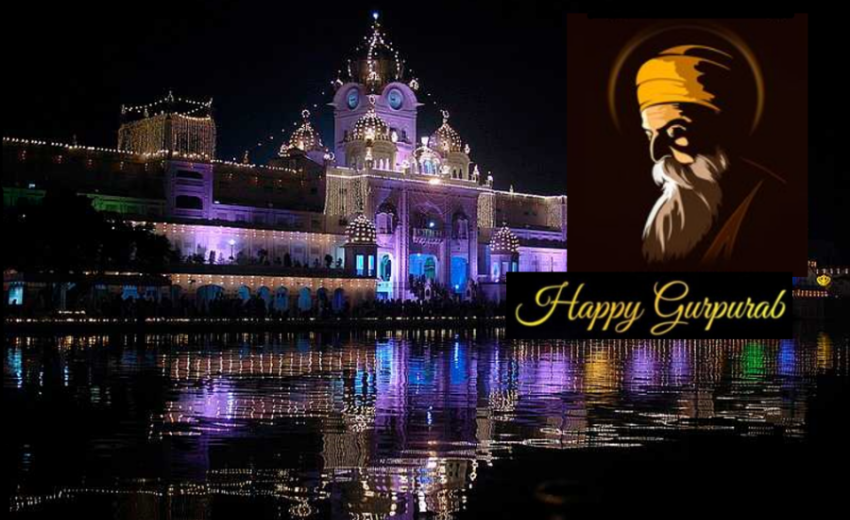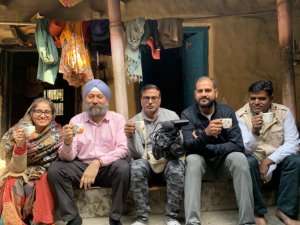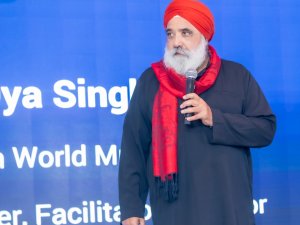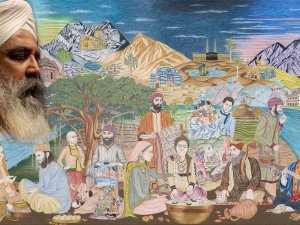I was watching a ‘Christmas’ feel good movie. One which has its ups and downs initially and normally ends well, with the jingle of bells denoting the mysterious arrival of Santa Claus. It normally brings a feeling of overwhelming love, well-being, goodwill, sometimes a tear or two, and everyone wishing each other ‘Merry Christmas’
I thought about us Sikhs …
Sikhism now appears to have two broad factions to it. A number of scholars are single-mindedly trying to distinguish between the ‘hearsay’ and what they call the ‘hijacking of Sikhi’ from the ‘facts’ as they see them. The other side is entrenched in the forklore and the tales (‘sakhian’) which have developed over generations of Sikh ‘godmen’ (sadhus, nirmalays, sants, babas, taksaliays, deras babas, bhais, and so on). One side looks upon Sikhi strictly as a tool of self-advancement, sticking mainly to what they see and research according to their ‘logical’ interpretation of the bani in the Sri Guru Granth Sahib. The other side revere and emulate what has been passed down by the ‘godmen’ – what Karl Marx called the ‘opium of the masses’ – the ‘sakhian’, ‘keramata(n)’, and otherworldliness, or, the‘sant-sipahi’ mode as they believe Guru Gobind Singh Ji envisioned, and even emulate the dress of the period – the ‘bana’
One side could have three-day marathon sittings of Waheguru Satsang, or other similar religious gatherings – the ‘akhand jaap’, the ‘akhand path’, forty-day silent jaap, lighting of divas, aarti, and other ancient Indian rituals and ceremonies. They believe in visions of the Gurus by the pious. The type who would bow to (supposedly) relics of the Guru Sahibs and even worship them. The other side advocate personal ‘khoj shabad main leh’ (research of Gurbani), discourses and generally streamlining procedures to barest minimum, education, and placing logic above all else.
Some of the ‘scholarly side’ attempt to ‘debunk’ any ‘bani’ of Guru Gobind Singh Ji, any writings in the Dasam Granth or any other post-guru period writers or brahmgianis, unless they wrote strictly on Gurbani from the Guru Granth Sahib. Their slogan – ‘Ik Granth Ik Panth’ !
I will refer to the two ‘sides’ as the ‘Babamuth’ (inclined towards the rituals) and the ‘Khojmuth’ (inclined towards facts or facts as they see them). At my age and general inclination towards gur sangeet, I have had close associations with both and I do see the worth of both sides. Evolution of Sikhi needs both sides – one to pacify the side which just wishes to pay lip service to what happens naturally with the majority – the herd mentality. The other, to keep the interests of the more inquisitive and those who like to be challenged where their personal development is concerned, majority being from the younger generations. (The elderly like me are generally set in their ways).
Over twenty initial years of my life in Malaysia and keeping in touch with the community there and associations especially with Sikh religious organisations and gurdwaras, I have noticed the initial ‘invasion’ of, for want of a better word, ‘Indian traditions mentality’ having crept into our smagams and gurdwaras. Rituals like ‘raakhi’ (rekhedi), puranmasi, lighting of candles during Divali which slowly continued under the guise of Bandhi Schod Devas (which we used to celebrate with our south Indian neighbours as their celebration known as Deepavali), Lori and Dussehra were unheard of! So, the counter-balance of Khojmuth, globally and generally, is very necessary to give us our own global identity.
On the other hand, attempting to remove almost everything connected with Guru Gobind Singh Ji, for example, is dangerous. Being challenged today, to my limited knowledge are: amrit sanchar; the first paudi of the conventional Ardaas; any shabads from the Dasam Granth; Deh Shiva (though even I believe that there is a legitimate alternate Sikh Anthem within the Guru Granth Sahib from, Jo tao prem khelan ka chao …); even Benti Chaupayi; Jaap Sahib. Raag Mala has been challenged since the turn of the last century); and so on.
I have friends who now refuse to recite the Benti Chaupayi within the Rehras Sahib. To me it feels like cutting off one of my limbs if I ever tried to do that! I once had a very loving fellow younger ‘vir’, great kirtenia in his own right, who warned me not to sing anything from the Dasam Granth as he would not be able to accommodate me! He was accompanying me that day. I wanted to sing ‘Mitr Pyaray nu haal muridhan dha kehna’ – one of my favourite shabads and my venerable father’s. Once in California, I was stopped mid-way from singing the Benti Chaupayi! Again, I was once abruptly asked to stop singing our rendition ‘Waheguru Bol Pyarea’ by some youth in Greater Kailash gurdwara in Delhi calling it ‘kechi bani’!
I urge caution on taking one side or the other. As some ‘rituals’ have evolved in too our gurdwaras over my lifetime, they hopefully will evolve out as there is greater ‘khoj’ and education. In my childhood and teenage-hood there were no 'visramqars' for Baba Ji to repose after 'samapti'!
I once had quite an illuminating discussion with some fairly affluent Sikh folk in Dubai. Whereas I was urging further research and ‘self-illumination’, they were of the view that all they wanted was, to be told what to do because they did not have the time nor the inclination to ‘illuminate’ themselves. “Tell us what to do that is good for our soul, and we shall do it! We do ‘parkash’ of Guru Granth Sahib and recite JapJi Sahib by ourselves every morning; listen to Jaap Sahib and Sawaiyay in our cars and at work, the occasional Sukhmani Sahib. In the evening we recite Rehras before ‘nashta’ (dinner). Before sleeping we recite Kirtan Sohila. We don’t even want to know what the Gurbani we recite or listen to means! We go to the gurdwara once a week at least, mainly on Saturday where we sit and listen to some nice sweet kirtan (does not matter that we learn nothing from it) and partake of langar. We attend important functions like Gurpurbs etc. and on invitation, for programmes in the gurdwara. All of us and our offsprings keep long hair. Our male folk tie dastaars. Our women folk generally go more often to the gurdwara; attend isteri satsangs; attend Sukhmani Sahib reading sessions and also help in the langar. We contribute ‘daswandh’ to the gurdwara.
WHY DO WE NEED MORE ‘ILLUMINATION’? WE RATHER SPEND THE TIME IN OUR BUSINESSES!”
We laughed and I could not fault their logic! That is the way most people, let alone Sikhs, are. They just like rituals, meaningful or not, more for enjoyment and appeasing the gods! Only some are discerning and wish to learn.
On the other hand, my venerable father used to ask me after every gurdwara smagam or even after seeing a movie – Aj phir ki sikhiya? (What did you learn today?) And I had to give him an answer followed by his own version. Greater learning for me. These lovely folk in Dubai (as an example) had a different answer – Aseen sikhan thodo aye haa(n)? Aseen ta(n) anandmanena si, aur maan leya. (We did not come here to learn anything! We came for the enjoyment and we enjoyed!)
Gurdwaras are there for the ‘masses’ and cater for them. Then we have some learned brahmgianis who the sangats like to hear and join in their ‘saintly’ veakheya, ‘simran’, ‘Waheguru jaap’ and simple kirtan. Some young kirtenias are very popular and cater for certain sections of the sangat (I have done my bit in that regard)! There are a new popular breed of young bilingual percharaks dressed in medieval garb who appeal to a certain section of our youth. They all create a certain ‘magic’ which is probably not in line with some of the views of the ‘Khojmuth’ types, but who appeal to the masses.
The khojmuths do not even like the word ‘magic’.
Let us take an example from Christianity. Come pre-Christmas, we see and feel a certain rise in excitement, joy and optimism with Christians visiting ‘home’; family gatherings, friends visiting, Christmas trees being decorated, presents, turkey dinners and general merriment. We all know, and they too, that Father Christmas, Santa Clause is a fictitious figure, but he exists for the children and for Christmas (and retailers). New movies come out propounding the ‘magic’ of Christmas and celebrations! It is even a fact that Jesus was definitely not born on 25th December, yet we have nativity plays and scenes created of his birth in a manger. They have midnight Mass on Christmas Eve, ushering in the birth of their saviour. So, I say,
let us not lose the ‘magic’ of Sikhi even if some aspects which bring us joy and celebration are fictitious, or just not fact.
In time, with greater education and research from our Khojmuths, we hope to see a responsible evolution (or maybe not), but let us not lose the simple magic of enjoying going to the gurdwara and attending simple sessions of Simran satsang and gatherings with a religious flavour, and don’t forget the langar!
I call it the KISS principle –Keep It Simple Sikha!
Let us remain one family not withstanding whether we agree fully with each other … and yet we need to keep learning. Some will want to learn. After all, that is what being a Sikh means. Others just want to belong and do the bare minimum. Let us be inclusive, not exclusive.
So this Gurpurab, let us just celebrate the birth of our beloved Baba Nanak even if some of us, especially the ‘Khojmuths’ believe that Baba Nanak was actually born around Vesakhi in April! Let us be happy and full of love for life and each other. Let us ‘enjoy’ Akhand Paths, extravagant langgars with metheyayi, classy kirteniay, dharmic kavetas about Baba Nanak and any other way we wish to celebrate.
HAPPY GURPURAB EVERYONE.
GURU JI’s BLESSINGS TO ALL SIKHNET READERS.
Dya Singh







